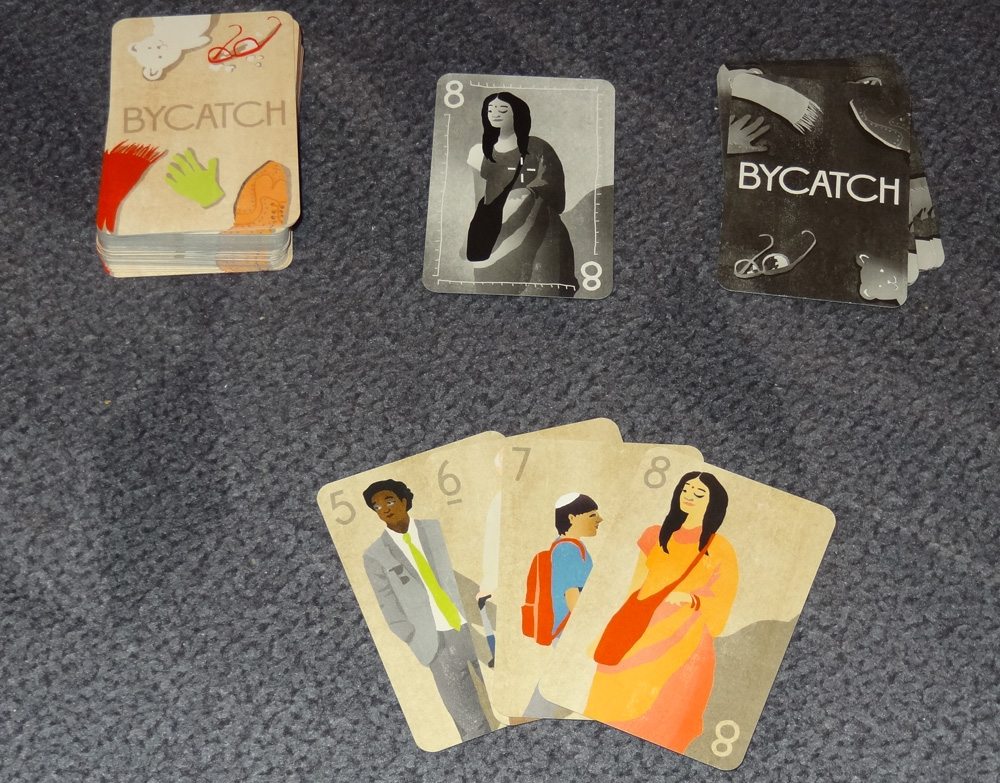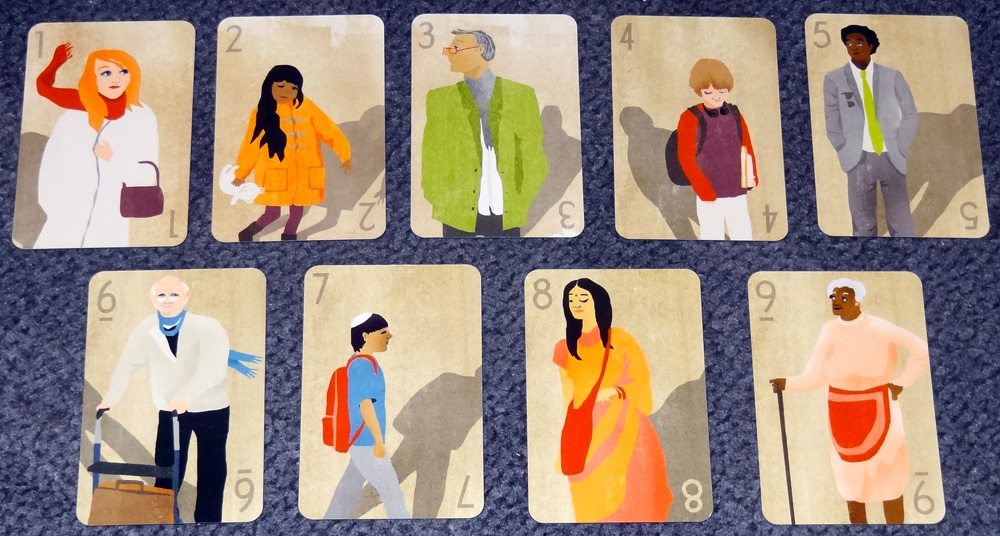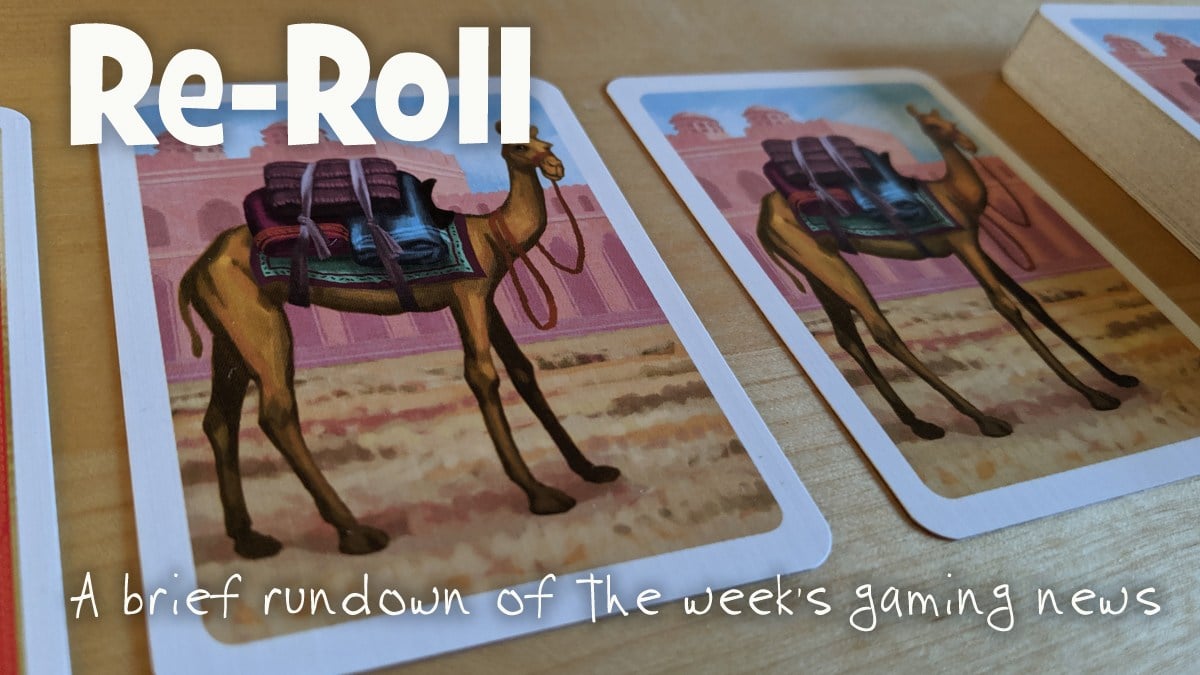When I first started up Bounded Enthusiasm, I figured I would use it to talk about all the various topics I cover on GeekDad: books, board games, apps, parenting, and so forth. But so far the podcast has always been book-based, talking to authors and illustrators (though I have talked about games with authors). In today’s episode, I’m branching out and talking to a game designer.
Subalekha Udayasankar designed the card game Bycatch because she had been learning about drone warfare and wanted a way to share some of the things she had discovered. I came across the game at XOXO last fall, where Udayasankar was running demos at the tabletop event, and I was pretty fascinated.
I’ll tell you more about the game here in this post in the form of a tabletop game review; my interview with Udayasankar is at the bottom of this post.
At a glance: Bycatch is a card game for 3 to 5 players, ages 12 and up, and takes about 20 minutes to play. It is available for purchase from the Bycatch website for $14 plus shipping. The age recommendation is about right; the gameplay itself is not too complicated, but the game may prompt tricky conversations about drone warfare that younger children may not be prepared for.

Components:
- 63 Citizen cards
- 9 Intelligence cards
Also required but not included: 1 camera phone (or digital camera) per player.
The Citizen cards are numbered 1 through 9, with 7 copies of each, and each number is represented by a person. The people are very diverse: a wide ranges of ages from young kids to elderly adults, male and female, and several different ethnicities. The Intelligence cards have the same 9 characters, but in black and white and as if seen through a camera viewfinder or, perhaps, a drone’s camera.
Each card has just the image and a number in the top left and bottom right corners, and nothing else. The artwork has sort of a cut-paper style to it (think The Snowy Day) and looks like it could fit in a picture book. The fact that any of these people could be suspects (and thus targets for a drone strike) is intentionally unsettling, because they look like “regular” people–but that’s sort of the point.

How to Play
The rules are available here as a PDF.
The goal of the game is to score the most points by sheltering citizens and suspects in your own nation and eliminating suspects in other nations.
To set up, you shuffle all of the Citizen cards and deal 7 to each player, leaving the rest as a draw deck. Shuffle the Intelligence cards and make a face-down pile of 3 plus the number of players. The rest are returned to the box. Turn the top Intelligence card face-up: this is the current suspect.
During your turn, you must admit a new citizen, and then you may take an action, and then you must control your borders.
Admit a new citizen: Draw a card from the top of the draw deck or the discard pile into your hand. If the card you drew is the current suspect, you may attempt to refuse entry. Show it to the other players, and place it face-down on the table. All other players put a card from their hand on the table. These cards are all shuffled, and each player takes one.
Take an action: You may do one action: shelter, surveil, or strike.

Shelter: If you have at least three cards that form a sequence (like 3-4-5), you may form a shelter by placing these face-up on the table in front of you. These citizens are protected from strikes. If one of these citizens is the current suspect, place the suspect card on top of the shelter, and reveal a new suspect. You may only build one shelter per turn, and may not add to existing shelters.

Surveil: Say “Surveil!” All players must freeze in position. Using your camera phone, you take a photo of somebody’s hand of cards. Players have to have cards splayed out–they may not hide cards behind other cards–and they have to keep their cards at least a hand’s-breadth away from another surface (so there’s room to put your camera there). You have to use the rear camera (not the selfie camera) so that you can’t see the picture as you are taking it.
Strike: Order a drone strike on a nation. Take three adjacent cards from a player’s hand and reveal them, and then place them face-down in front of you. If any of these cards match the suspect, the strike was successful–take the suspect card and place it on top of the cards, and then reveal another suspect. If none of them match, then the strike failed, and all you have is collateral damage.
Control Borders: At the end of your turn, you draw up to 5 cards or discard down to 7 cards, whichever is applicable. You may not discard the current suspect this way.
If the deck runs out, reshuffle the discard pile (if any) and form a new draw deck. The game end is triggered when either there are no more cards to form a new draw deck or when the Intelligence deck is depleted. Each player gets one more turn to shelter or strike (or pass), and then the game ends.
Scoring is as follows:
- Shelters are worth 20 points for the first 3 cards, and then 20 points for each additional card after that. If a shelter had a suspect in it, the score is doubled.
- Eliminated suspects are worth 100 points each.
- Collateral damage–any non-suspect that was killed in a strike (even successful ones)–are worth negative 10 points each.
Highest score wins.

The Verdict
Bycatch is a game that will make most people uncomfortable to some extent as soon as they think about the theme and the implications. You can play it just as a card game, ignoring the theme and just playing for points, but it’s hard to ignore the fact that the suspects that you’re targeting with drone strikes include little kids and an old man with a walker. Even the scoring is thought-provoking: why do innocent civilians only cost you 10 points as collateral damage? At 100 points for a suspect, it’s often worth calling a strike if you know a suspect is in a player’s hand–even if you fail, you’re only losing 30 points. It raises questions about how our nation places relative values on eliminating suspects versus preventing civilian casualties: what is the real-world “scoring” table, and who created it?
The game itself does have a big element of chance in it–if you happen to draw a lot of sequences, you can build shelters, racking up points without any risk of collateral damage, and if your shelters include suspects, then you double the points. Since you can draw from the top of the discard pile, you can mitigate the luck a little–but only if there are cards in the discard pile, which happens when somebody has more than 7 cards at the end of a turn. In my experience, between the shelters and strikes, it doesn’t happen often.

Surveillance isn’t always a great move–for one, you’re quite likely to get a photo that doesn’t provide any useful information. At XOXO, we had low lighting conditions, and so players had a choice between using a flash and getting a totally washed-out photo, or turning off the flash and getting something really dark and grainy. And, of course, that’s assuming you even got the cards within the frame–quite often you get photos of thumbs or half of one card.
But, as they say, the faultiness of surveillance is a feature, not a bug. All you need is a portion of a card to identify a suspect, and you can call a strike on your next turn. (Of course, even then you’re not guaranteed to hit the suspect.) I think it’s an accurate reflection of real drone strikes, because it’s an action taken based on imperfect or incomplete information. At least in the case of the game, it could be outdated information: by the time you strike, the player could have rearranged the cards in their hand (and they should, if they’re harboring suspects and a drone just flew over).
The other interesting thing about surveillance, though, is that as new suspects are revealed, you may discover that your old photos already caught somebody hiding in a player’s hand. So there is value in early surveillance, as long as you pay attention to whether that card has been sheltered or eliminated in the meantime.
I don’t think Bycatch is necessarily a game I’ll play repeatedly with the same group of players, but it is one that I think is very valuable as an example of how a game could educate and provoke discussion on a difficult subject. It’s one that I do like to introduce to new players who haven’t seen a game like this before. What was interesting to me is that the game isn’t preachy–the message is embedded in the mechanics, not explicitly stated anywhere in the rules.
It reminds me a little of the game Train by Brenda Romero, which I read about a few years ago. (Trigger warning: it’s about the Holocaust.) It’s a game intended to be played once–because then you realize the horrors of what you’re doing as you play the game. Bycatch is perhaps not quite as shocking and I think can be played multiple times, but it is still unsettling.
For the podcast, I spoke to Udayasankar about her motivations for creating Bycatch and what sorts of reactions she has gotten to the game. You can download the MP3 here, or listen in the embedded player below.
Your browser does not support the audio element.
Two things Udayasankar referred to in the podcast are this Guardian article about drones and this interactive infographic from Pitch Interactive.
Thanks to Gerry Tolbert for audio wrangling!
Podcast: Play in new window | Download (22.8MB)
Subscribe: RSS





